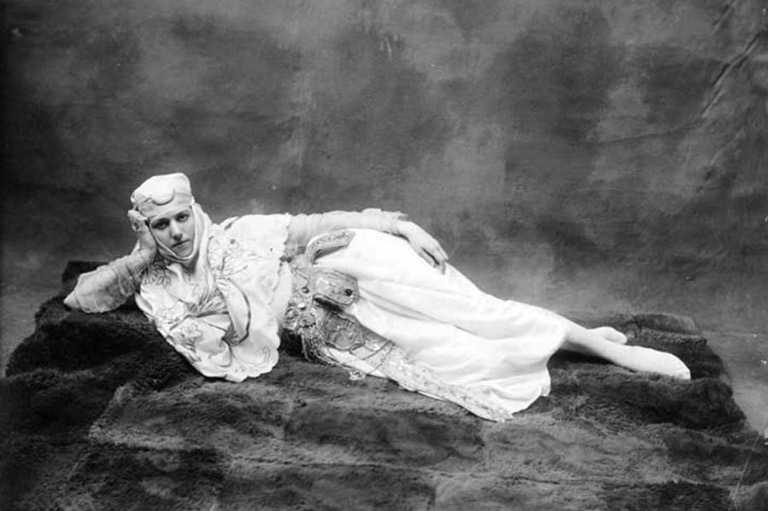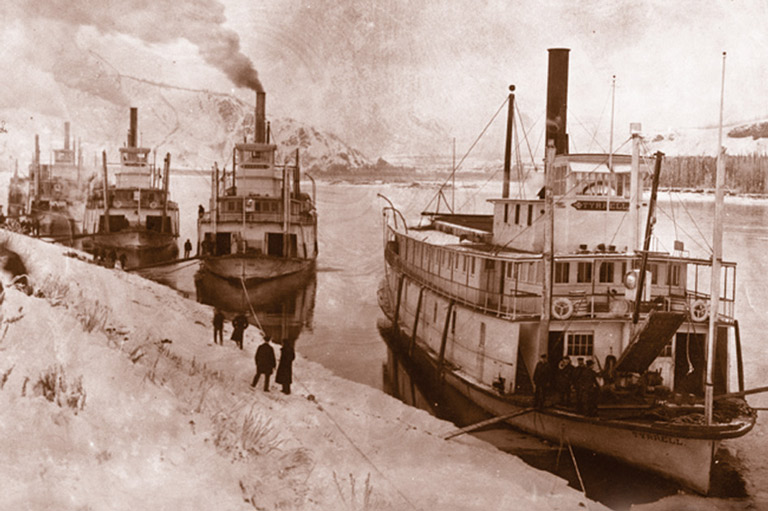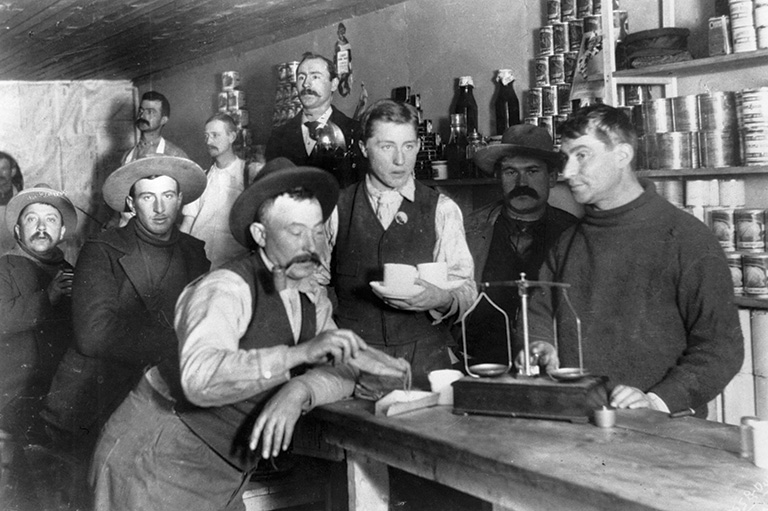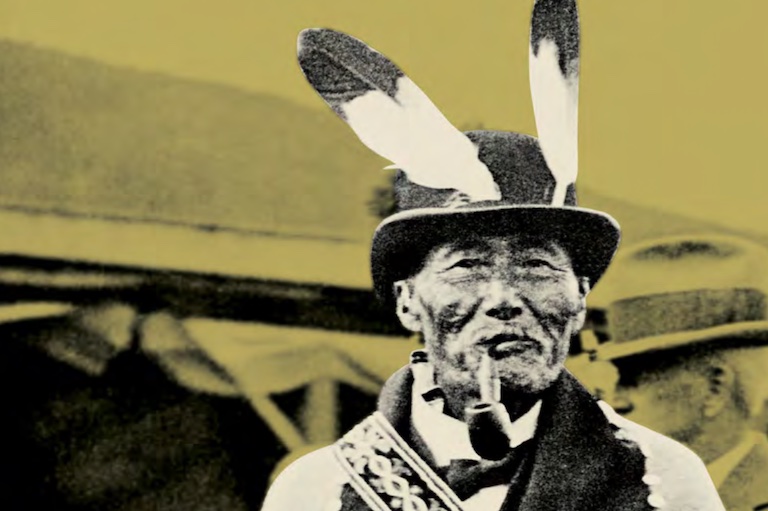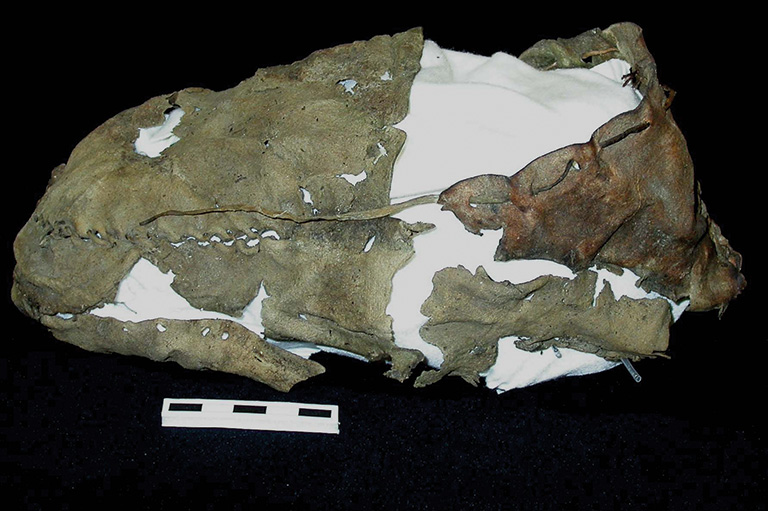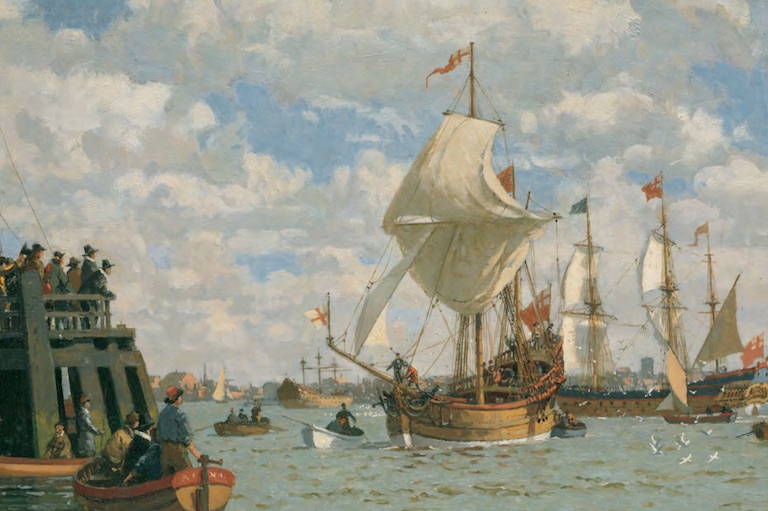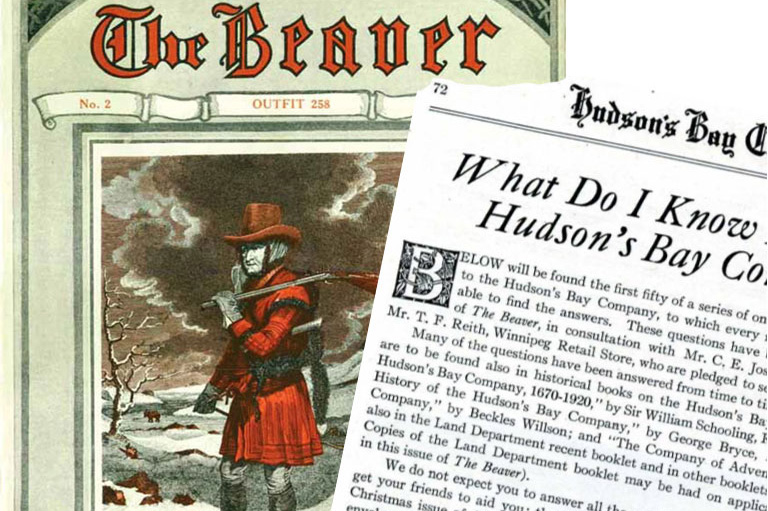Unearthing Eldorado
William Scouse was a sourdough who arrived in the Yukon Valley some months before the celebrated Bonanza Creek gold discovery of August 1896. With his companions, he staked a claim on one of Bonanza’s tributaries — or “pups” — Eldorado Creek. The claim proved fabulously rich, and Scouse died a wealthy man. His story became a favourite local anecdote, recounted in numerous histories of the Klondike.
Story continues below.
Photo Gallery
-
 Fortune seekers climb the "golden stairs" of the Chilkoot Pass on their way to the Yukon gold fields, circa 1898-99.Library and Archives Canada
Fortune seekers climb the "golden stairs" of the Chilkoot Pass on their way to the Yukon gold fields, circa 1898-99.Library and Archives Canada -
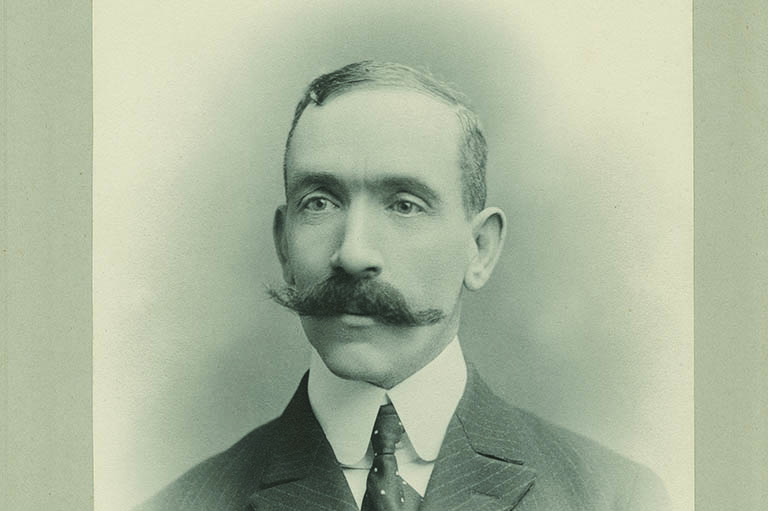 Prospector William Scouse, circa 1903.CMH/William Scouse Collection
Prospector William Scouse, circa 1903.CMH/William Scouse Collection -
 Prospector William Scouse and his wife Zidania in Paris in 1903. The photo was likely taken during their honeymoon.CMH/William Scouse Collection
Prospector William Scouse and his wife Zidania in Paris in 1903. The photo was likely taken during their honeymoon.CMH/William Scouse Collection -
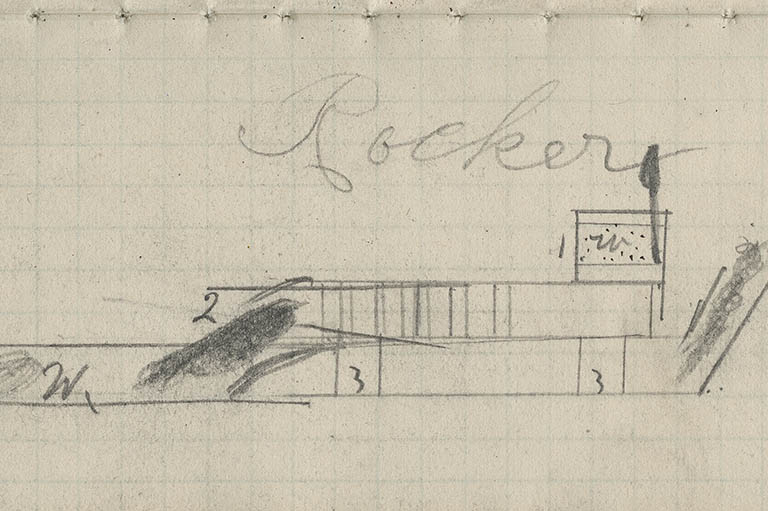 A pencil-drawing of a rocker box, or cradle, used to separate gold nuggets from sand and gravel. The drawing appears in prospector William Scouse's diary.CMH/William Scouse Collection
A pencil-drawing of a rocker box, or cradle, used to separate gold nuggets from sand and gravel. The drawing appears in prospector William Scouse's diary.CMH/William Scouse Collection -
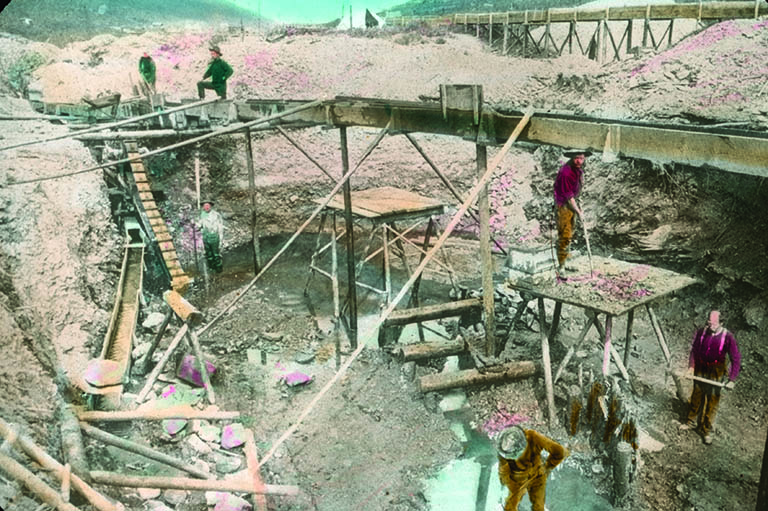 Miners at work at the Eldorado mine in the Yukon, circa 1998-1900.Glenbow Museum
Miners at work at the Eldorado mine in the Yukon, circa 1998-1900.Glenbow Museum -
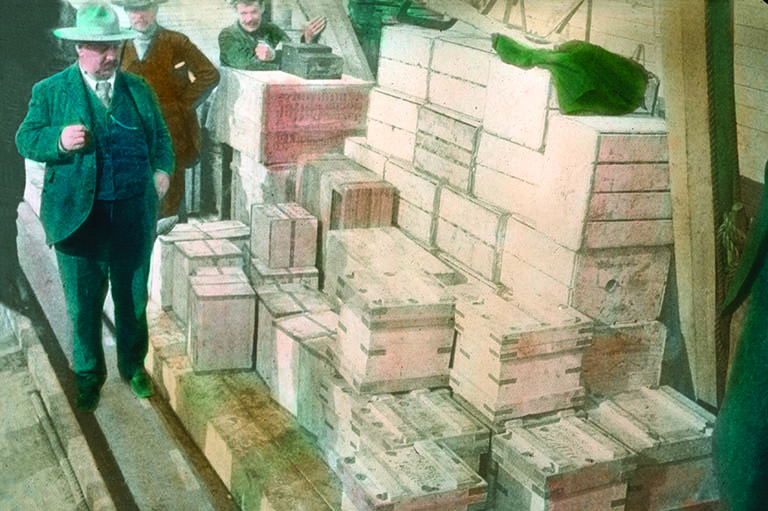 A shipment of gold leaves Dawson City, Yukon, circa 1898-1900.Glenbow Museum
A shipment of gold leaves Dawson City, Yukon, circa 1898-1900.Glenbow Museum -
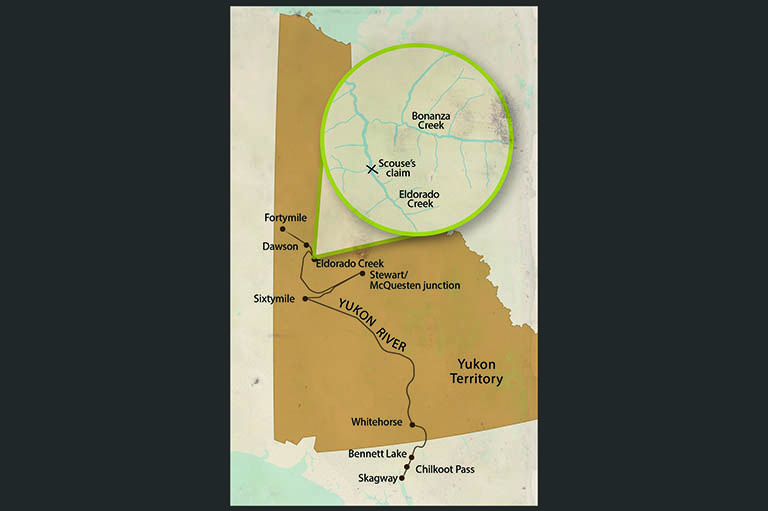 The map shows the Scouse party's route from Skagway north, first to the Stewart/McQuesten junction and then to Eldorado Creek, where a significant gold mine was found.Matthew Yathon
The map shows the Scouse party's route from Skagway north, first to the Stewart/McQuesten junction and then to Eldorado Creek, where a significant gold mine was found.Matthew Yathon
Until recently, historians were unaware that Scouse kept his own account of the Eldorado discovery in the form of a tiny pocket diary, carefully preserved by his descendants in Washington state. The Canadian Museum of History recently acquired the diary, along with Scouse’s personal and business paper, and a collection of jewellery fashioned from raw gold nuggets, the latter presumably extracted from his claims.
Never intended for a wide readership, Scouse’s diary is practical in content and spare, even understated in style. But it is exciting as a heretofore unknown first-person account of one of the Klondike’s most significant strikes.
The late nineteenth-century Yukon attracted restless wanderers, and the Scottish-born Scouse was no exception. What Scouse lacked in formal education he made up for with his keen eye for geology. He worked for a colliery in Nanaimo, British Columbia, and his practical experience in identifying mineral formations served him well in the Yukon. Realizing the Yukon was rich in undiscovered gold, he headed there with three companions in the early spring of 1896. Like other gold seekers, they faced a long and arduous journey, suffering snow blindness along the way.
With 7 uniquely curated newsletters to choose from, we have something for everyone.
By August, news broke of a significant gold find at Bonanza Creek, near the confluence of the Yukon and Klondike rivers. The news travelled quickly, so Scouse and his companions raced to arrive ahead of other gold seekers.
Bonanza was already entirely staked by the time they arrived, but the party staked claims on its pup, Eldorado. Five shafts soon penetrated Eldorado No. 14 and 15, plunging three metres or more down through black muck toward the bedrock. The temperature dropped to -23 Celsius, and snow fell almost daily. Scouse’s briefer and briefer diary entries suggest a single-minded focus on the task at hand and hint at discouragement. “Still sinking but no prospect yet,” he wrote on November 6.
By November 14, with the temperature now approaching -34 Celsius, a real strike seemed imminent. On December 4, Scouse’s diary began with the weather — “Mild with a little snow” — and then recited a litany of pans worth as much as twenty dollars each. The next day, as they scraped ore from the bedrock, the best pan yielded over forty-five dollars. In today’s dollars, this single pan of gravel would have been worth almost $3,000.
After December 5, Scouse’s diary became a simple account book, so busy were he and his partners in shovelling and washing pay dirt. Each day for the rest of the year, he recorded only a tally of the value of the gravel panned. On December 6, twelve pans yielded $272.78 in gold, with a value today of over $17,000; the best pan the next day gave $122.18, or almost $8,000 today.
Scouse and his companions thus joined the select group of miners who would make their fortunes in the Klondike. The successful Klondike prospector squandering his new-found riches on champagne baths and the affections of dance hall girls is a pervasive, and in some cases accurate, stereotype. The Scouse party, however, avoided this fate. Although Scouse’s diary ends in 1896, an accompanying collection of business correspondence shows that he was sufficiently savvy to avoid losing his fortune.
He invested his earnings in real estate in the south, increasingly in the Seattle area, where he wintered after 1903 with his American wife, Zidania. And every spring he came back to the Yukon to mine the creeks and gulches of the Klondike watershed, perhaps hoping for the next big strike, perhaps satisfied with smaller, post-gold rush returns. At his death in 1918, Scouse had lived in the Yukon longer than anywhere else. His family would maintain placer claims in the territory into the 1940s.
Scouse’s diaries and papers offer clues as to why some prospectors succeeded while most failed. Their unexpected rediscovery sheds new light on the adventures of a legendary figure of the Klondike gold rush.
We hope you’ll help us continue to share fascinating stories about Canada’s past by making a donation to Canada’s History Society today.
We highlight our nation’s diverse past by telling stories that illuminate the people, places, and events that unite us as Canadians, and by making those stories accessible to everyone through our free online content.
We are a registered charity that depends on contributions from readers like you to share inspiring and informative stories with students and citizens of all ages — award-winning stories written by Canada’s top historians, authors, journalists, and history enthusiasts.
Any amount helps, or better yet, start a monthly donation today. Your support makes all the difference. Thank you!
Themes associated with this article
Advertisement
You might also like...

Canada’s History Archive, featuring The Beaver, is now available for your browsing and searching pleasure!

